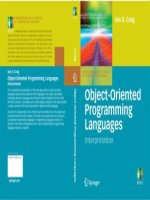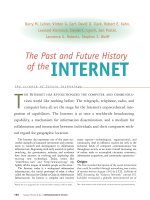history of programming languages
Bạn đang xem bản rút gọn của tài liệu. Xem và tải ngay bản đầy đủ của tài liệu tại đây (759.3 KB, 34 trang )
History of Programming
Languages
History of Programming Languages
Punch cards
Jacquard looms
Analytical engine
(Charles Babbage and
Ada Byron Lovelace)
US Census data
(Herman Hollerith)
Hand-coded machine
language programs
10110000 01100001
Assembly language
programs
movl $3, %eax
Modern programming
languages
Charles Babbage’s
Analytic Engine 1834
●
Earliest known computer
●
Never fully built
●
Operations and variables on separate punch cards
●
Conditional jumps accomplished mechanically by
physically jumping over a band of cards
●
Collaborator Lady Ada Byron, Countess of Lovelace.
●
Babbage first computer scientist. Ada Byron first
computer programmer.
Von Neumann
architecture 1945
●
Mathematician John von Neumann. Part of design of
ENIAC, one of first electronic computers.
●
Computer in his design consists of small CPU, larger
main memory, bus
●
Single CPU architecture still referred to as von Neumann
machines.
●
EDVAC report (Electronic Discrete Variable Arithmetic
Computer) describes the first stored program computer.
Programming Language Generations
First Generation
(late 1940s):
Machine-level
programming languages
Fast and efficient, executed
directly on the CPU
Consists only of 0s and 1s
Difficult for humans to read,
write, and debug
Programming Language Generations
Second Generation
(early 1950s):
Symbolic assemblers
Interpreting routines
Very early compilers
Assembly languages
Simple mnemonic instructions <opcode> <operands>
Assembler translates into machine code
Handcoding in assembly only for low-level needs
Programming Language Generations
Third Generation
(mid 1950s - present):
High level, general-purpose
FORTRAN, LISP, COBOL, ALGOL
(Ada, Basic, C, C++, Java, Pascal, Smalltalk, …)
Easier for humans to read, write, debug
Compiler translates into machine code before running
Interpreter translates into machine code at runtime
Programming Language Generations
Fourth Generation (1970s - ):
Specification languages, query languages, report
generators, systems engineering
Maple, Mathematica, Postscript, SPSS, SQL
Fifth Generation (1980s - ):
Solve problems using constraints rather than
algorithms, used in Artificial Intelligence
Prolog
Konrad Zuse’s
Plankalkül 1945
Language for expressing
computations
Not published until 1972
Anticipated many developments of
programming languages
Arrays, records
Assertions
Algorithms for sorting, numerical computations,
syntax analysis, and chess
K. Zuse
A family tree of languages
Fortran
BASIC
Cobol
LISP
Scheme
ML
Prolog
PL/1
Algol 60
Algol 68
Pascal
Modula 3
Ada
C
C++
Simula
Smalltalk
Java
Dylan
Ruby
Perl
Python
C#
Evolution of third-generation
Languages
Begins with FORTRAN in 1954
Generation of high-level programming
languages
Languages stress expressivity and machine
independence
Programming is procedural
Includes imperative, functional, compiler
languages
FORTRAN (1954)
●
Designed at IBM to efficiently translate
mathematical formulas into IBM 704
machine code. Wanted code at least as
efficient as hand-coded.
●
Language design was secondary to compiler design for
optimization
●
1954 Report for a proposed Formula Translating System
●
1957 FORTRAN language manual published
●
Translator produced code that in some cases was more
efficient than the equivalent hand-coded program.
John Backus
Innovations of Fortran
language based on variables, expressions,
statements
the form of the arithmetic-assignment statement
conditional and repetitive branching control
structures
arrays with maximum size known at compile time
provision for comments
LISP (1958)
●
Interactive functional language
●
Designed for IBM 704 by John
McCarthy at Dartmouth 1956-1958
●
Implemented at MIT. First reference
manual published in 1960.
●
Language based on lambda calculus. (Mathematical
notation for expressing functions.)
●
LISP was designed for symbolic formula manipulation.
Stands for LISt Processor.
●
Has become standard language of the AI community
John McCarthy
Innovations of LISP
the function as the basic program unit
the list as the basic data structure
dynamic data structures
facilities for "garbage collection" of unused memory
use of symbolic expressions as opposed to numbers
recursion and the conditional expression as control
structures
the "eval" function for interactive evaluation of LISP
statements
ALGOL (1958)
●
Designed by international team
●
ALGOrithmic Language
●
Several revisions:
●
ALGOL58
●
ALGOL60
●
ALGOL68
●
ALGOL60 had profound influence on programming language
design and on computer science. Pascal carries on tradition.
●
ALGOL68 was a huge, general purpose language, not widely
accepted.
●
Language description published in ALGOL60 report
●
First appearance of Backus-Naur Form for programming language
definition
●
Widely used as a publication language for algorithms
Peter Naur
Innovations of ALGOL60
block structure and localized data
environments
nesting of program units
free format program code
explicit type declarations
dynamic memory allocation
parameter passing by value and by name
Cobol (1960)
●
US Dept of Defense wanted
“common” PL for data processing
●
CODASYL committee (Conference on Data Systems Languages)
●
Result was COBOL in 1960 (COmmon Business-Oriented Language)
●
Grace Hopper was involved in development and wrote 1
st
compiler
●
Designed to be machine independent, unlike FORTRAN.
●
Influenced by Fortran, ALGOL58, and English.
●
Example:
●
Multiply A by B giving C
●
Perform <loop body>
●
Varying J from 2 by 1
●
Until J > N.
●
Major revisions standardized and released in 1968, 1974, and
1985.
Grace Hopper
Innovations of COBOL
the record data structure
file description and manipulation facilities
machine independence of data and program
descriptions
influence of English
relatively natural language style, including
extra words for readability
effort toward a language that would produce
self-documenting program code
APL ( early 1960s)
●
A Programming Language
●
Based on notation developed by Ken Iverson at Harvard
1957-1962.
●
Functional, interactive, science-oriented language that
assumes the array as the default data structure.
●
Suitable for applications with a heavy use of numerical
data in large multi-dimensional arrays.
●
Used special symbols requiring special keyboard /
printer
BASIC (1964)
●
Developed at Dartmouth in 1960’s by Tom Kurtz, John Kemeny,
and a succession of undergraduates; first ran in 1964.
●
Beginner’s All-purpose Symbolic Instructional Code
●
Intended to introduce students in non-scientific disciplines to
computing.
●
Influenced by FORTRAN and ALGOL.
●
Major goal to simplify user interface:
●
Simplicity chosen over efficiency
●
Time sharing over punched cards
●
Distinctions such as int vs real eliminated
●
Automatic defaults for declarations, values, arrays, output format, etc.
●
Clear error messages
●
Students had access to computers at all times
●
No universal BASIC standard:
●
ANSI (American National Standards Institute) is a minimal standard.
●
True Basic – Kemeny’s company
PL/1 (1964)
●
Planned and designed by IBM as an extension to
FORTRAN
●
“Extension” departed from FORTRAN specs and was
first released as NPL. Renamed PL/1 (Programming
Language 1)
●
Of interest in academic community because it had every
element of language design. Too big and complicated.
●
Compiler sold separately from machine
●
COBOL and FORTRAN already had huge user bases
Innovations of PL/1
multitasking
programmer-defined exception handling
explicit use of pointers and list processing
wide variety of alternatives for storage
allocation (static, automatic, controlled)
consideration of problems arising from
interacting with operating system
ALGOL68
●
ALGOL committee produced considerably revised
and extended version of ALGOL in 1968 .
●
Huge, general-purpose language, very different from
ALGOL60
●
Not well accepted:
●
overly complicated and impractical
●
difficult for compiler writers
●
ALGOL68 introduced:
●
User-defined data type
●
Pointer type
(Both significant features of Pascal)
Pascal (1970)
●
Designed by Niklaus Wirth
●
(member of ALGOL committee; he proposed
a revision known as ALGOL-W in 1965)
●
Pascal first implemented in 1970.
●
In opposition to trend of PL/1 – ALGOL68 – Ada
●
Named after 17th century French philosopher and
mathematician Blaise Pascal.
●
Simple and elegant
●
Widely used in academic community
●
Interesting features:
●
Case statement
●
Facility for user-defined data types
●
Record structure
Niklaus Wirth









